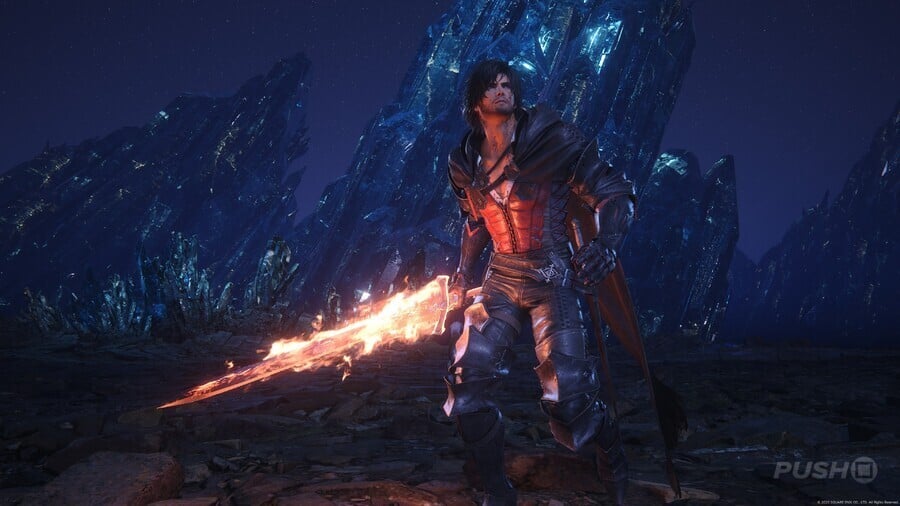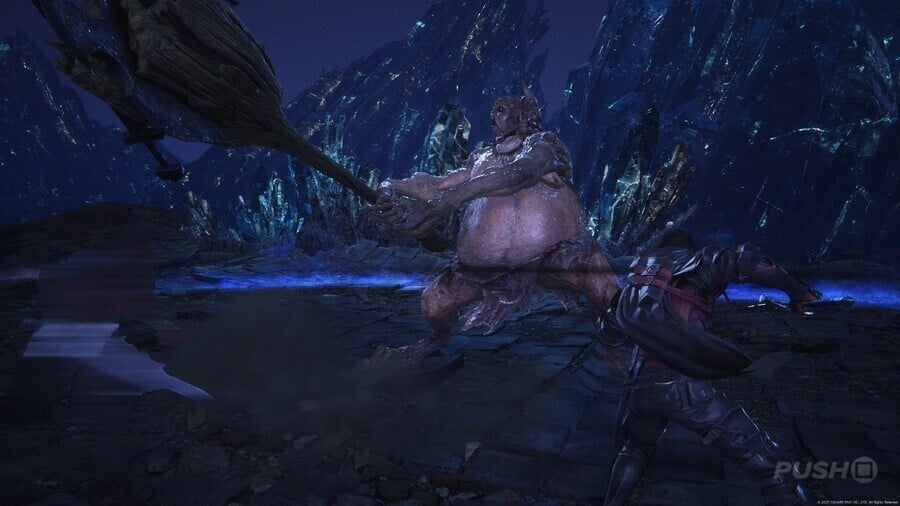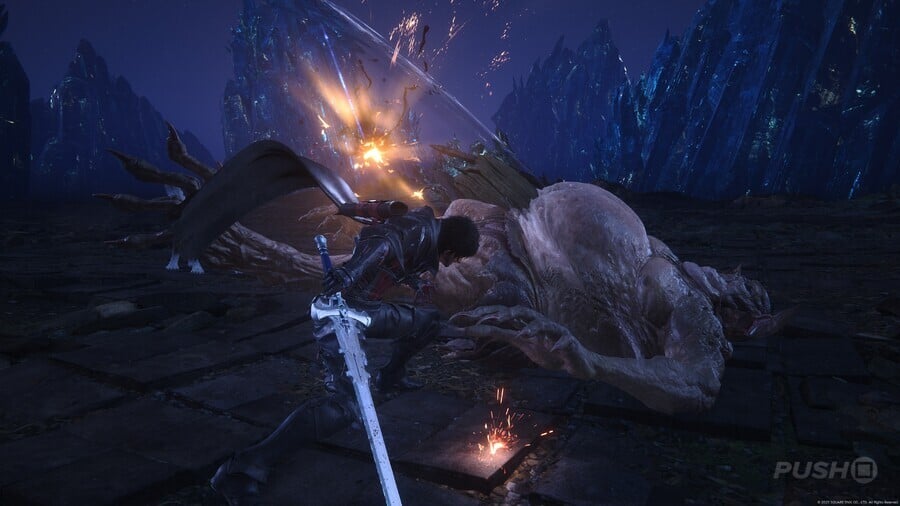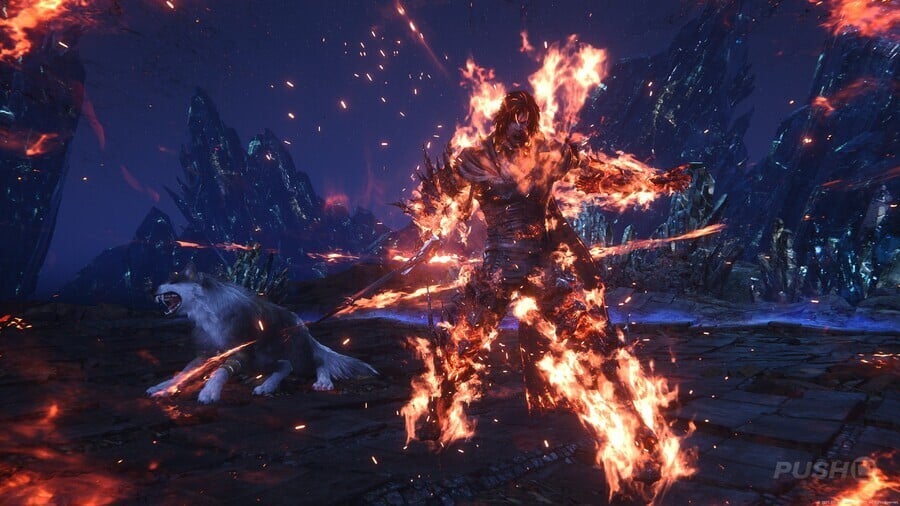
Looking for Final Fantasy 16 combat tips? In this Final Fantasy 16 guide, we're going to detail 13 tips that should help everyone get better at the game, regardless of whether you're a total beginner or someone who's looking to explore more advanced techniques.
Without further ado, here are our Final Fantasy 16 combat tips.
Subscribe to Push Square on YouTube166k

Dodging Is Your Defence
Dodging incoming attacks is the key to success in Final Fantasy 16. That may seem like an obvious point to make, but if you do master the game's dodge mechanic, you'll be able to breeze through whole boss battles without taking any damage.
Clive's dodge (mapped to R1 by default) is fairly generous. You can be a little bit early or a little bit late and you'll generally still trigger the precision dodge, from which Clive can counterattack with his sword or with magic. Once you're used to the more precise timing of Clive's evasion, you'll quickly find that combat against tougher enemies becomes much more manageable. If in doubt, dodge.
Dodge Directly Into Your Enemy's Attacks
Building on our first tip, a good way to make your dodging more effective is to dodge into your opponent's attacks. What we mean by this is instead of dodging away from a foe's axe swing, for example, direct Clive into the axe with his dodge. This technique can be really helpful if you're trying to time your dodges better, because it ensures that Clive's precision dodge activates as soon as he makes contact with the incoming weapon, claw, or magical attack.
This tip is especially useful against magic projectiles, as it allows Clive to slip straight through them, closing the gap between you and your opponent.
Dodge the Swing, Not the Windup
Many enemies in Final Fantasy 16 will try to catch you out by slightly delaying their attacks. Their animation will telegraph the fact they're about to attack, but dodging as soon as you see movement will almost always mean that you get hit by the actual swing.
As a general rule, you should always try to time your dodges against the swing, not the windup. Now, obviously, you'll often need to have a read on your opponent's attacks before this becomes second nature, but the bottom line here is that you shouldn't spam your dodges. Watch your enemy carefully, and dodge when its blow is just about to make contact with Clive. Keeping a cool head is the key here.

Make the Most of Stagger
When an enemy is staggered, it becomes completely vulnerable for a reasonably long amount of time. During this window, Clive's attack power is increased and the goal is to deal as much damage as you possibly can. As such, it's usually a good idea to have your Eikon skills lined up so you can chain them all together and really dish out some pain.
There is some nuance to understanding how stagger works, though...
Save Your Best for Last
Attacking a staggered opponent builds up a damage multiplier, which can be increased to a maximum of 1.5 (meaning that Clive is dealing 1.5x his usual damage). The multiplier increases based on the number of hits that you land during the stagger.
In order to maximise your damage output, you should start with your less damaging Eikon abilities and work your way up. For example, kick things off with Clive's standard sword and magic combo to get that multiplier ticking. Then, go in with a multi-hit Eikon attack to raise it even higher. Unleash a couple more, and when the multiplier is at its peak, go all-out with your most powerful Eikonic strike, pushing its damage to the limit.
Spamming Eikon Attacks Isn't Always Ideal
It's always tempting to burn through your Eikon abilities when your opponent is staggered. After all, that's the best way to deal maximum damage. However, there are specific situations where saving your special moves for the rest of the battle can prove to be a better strategy.
Some bosses, for example, will start conjuring super powerful attacks after being staggered and having their HP reduced to a certain amount. When this happens, you'll need to break the boss' composure before its destruction can be unleashed. Needless to say, having all of your Eikon abilities on cooldown is not ideal.
It's also worth noting that some Eikon skills — specifically the ones that are designed to counter particular attacks — are probably worth saving as well, as their base damage is fairly low to begin with.

Eikon Abilities Are All-Important
Making the most of your Eikon abilities is what separates advanced players from everyone else. Clive can equip up to a maximum of six Eikon abilities, and by the end of the game, there are a lot of choose from, many of them boasting unique effects that can alter your style of play.
Knowing when to use your Ekionic powers is crucial, as is having a good understanding of what they're designed to do.
Variety Is the Spice of Life
A varied approach to your Eikon ability loadout can be key to squeezing Final Fantasy 16's combat system for all it's worth. Some Eikon skills are raw damage-dealing attacks that are best saved for when an enemy is staggered. Others are fast and simple to the point where you can get away with using them mid-fight.
Ideally, you want access to a range of different Eikon abilities to suit the game's ever-changing battlefield. The core of your loadout should always focus on dealing good damage, but it's best to surround these base abilities with more situational techniques.
Special moves that focus on countering an opponent's attacks, for instance, can be a huge benefit to any style of play. Likewise, defensive abilities can bolster Clive's survivability considerably.
Avoid Too Many Long Cooldowns
You can't really go wrong with slotting your favourite Eikon abilities, but one thing you should always try to avoid is having too many techniques that suffer from long cooldowns. In particular, an Eikon's most powerful attack — the expensive skill that's found at the bottom of each tree — is always offset with a long cooldown that can last more than a minute.
Now, if you equip a bunch of these super strong attacks, you'll be able to dish out some serious damage — but you'll also blunt your offensive potential for a huge chunk of the battle that's to come. There's absolutely nothing wrong with cherry picking one of two of these super moves for your loadout, but going all-in on them will significantly limit your options.

Limit Break Is Your Lifeline
Limit Break is a mechanic that's unlocked fairly early in the game, and it allows Clive to enter a powered-up state for a limited amount of time. His damage is increased, his standard combo is altered and lengthened, and all of his Eikon abilities are enhanced. And as if that wasn't enough, Clive's HP is slowly restored, and enemy attacks won't flinch him (although they will still deal damage).
You build Clive's Limit Break by dishing out and taking damage, and it does increase quite quickly. As such, you certainly shouldn't be afraid of using Limit Break whenever you want to deal extra damage, or if you're in a tough spot where you could do with regenerating a bit of HP.
In more difficult battles, Limit Break should be considered Clive's lifeline, as it can help turn the tide when you're struggling to get a good read on your opponent. Even just using Limit Break defensively — staying away from the enemy while your HP ticks up — is a very viable option.
Cancel Your Limit Break for Efficiency
You can actually cancel Clive's Limit Break early by pressing L3 and R3 together while it's active. Upon cancellation, the Limit Break gauge will drain down to the next segment — so cancelling with the correct timing is important — but you can basically save a portion of your bar for the rest of the battle.
Now, admittedly, cancelling your Limit Break isn't always an especially useful thing to do; you've probably activated it in order to deal massive damage or to help you survive a hard fight. But there is some depth here for more advanced players, as utilising your Limit Break in quick bursts can actually benefit specific Eikon attacks and combos.
For example, if you have an Eikon ability that generates high stagger damage, triggering your Limit Break before using it will make the effect even more potent. Once it's done, cancel out and you'll have maximised your damage without burning more than a segment of your gauge. There's a lot of potential for particular combinations here.

Parrying Is King, But It Ain't Easy
Parrying is perhaps the most advanced technique in the whole of Final Fantasy 16. A parry occurs when one of Clive's sword attacks perfectly clashes with an incoming blow, resulting in a brief window of slow motion where the opponent's attack is cancelled and Clive deals increased damage.
As you might have already realised, actually performing a parry isn't easy. The timing is incredibly tight, and it differs based on the opponent and the attack that's being parried. Adding yet more complexity, some attacks simply can't be parried (as far as we can tell, anyway).
If you can somehow become a parry master, you'd no doubt see Final Fantasy 16's difficultly crumble before your eyes. And if that sounds like a worthwhile goal, you'll definitely want to practice in the training arena, where the stakes are obviously much lower.

Don't Forget About Torgal
Torgal, Clive's trusty hound, will fight alongside you for much of Final Fantasy 16. Torgal is the only party member who you can command (via the directional buttons), and he does have his uses in battle.
Against basic enemies, Torgal can be used as a combo starting or extending tool. His standard bite (up on the d-pad) counts as one additional attack and can be used on an opponent that's in the air. Meanwhile, his more powerful rush (down on the d-pad) can launch your foes off the ground. You can rack up some impressive combos with Torgal's help.
Torgal also comes with a healing move (right on the d-pad), but it's not as effective as you might think. The heal only applies to the grey on Clive's health bar, and the healing itself is very gradual, so it's definitely not a substitute for using potions.
Still, making liberal use of Torgal's heal can keep your HP reasonably high over the course of longer battles, potentially lessening your reliance on potions when the going gets tough. As a general rule, it's worth telling Torgal to heal whenever you see grey HP.
Did you find our guide on Final Fantasy 16 combat tips helpful? Take up your sword and be sure to check out our Final Fantasy 16 guide for much more help with the game.





Comments 0
Wow, no comments yet... why not be the first?
Leave A Comment
Hold on there, you need to login to post a comment...